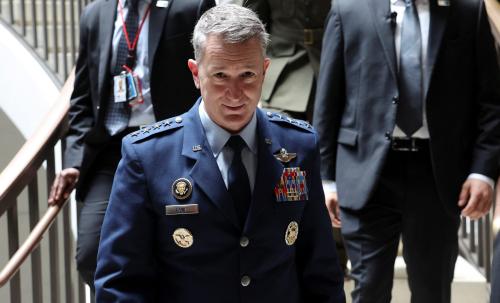According to recent reports, Pentagon officials are considering cuts in several weapons programs as they develop their 2004 budget proposal. If defense spending is to be kept within reasonable bounds, these are exactly the sorts of reductions that will be required.
Otherwise a total defense budget that has already grown from $300 billion when U.S. President George W. Bush took office in 2001 to roughly $400 billion in 2003 may reach $500 billion by the end of the decade. Although not astronomical as a percent of gross national product, such a budget would deprive the government of resources needed for important domestic programs and for deficit reduction.
The proposed cutbacks, developed by Defense Secretary Donald Rumsfeld confidant Stephen Cambone at the Pentagon’s office of Program Analysis and Evaluation, are said to focus on five main weapons programs. Three are in the army, one in the navy, and one in the air force. Meanwhile, the Marine Corps V-22 program is surely only another accident away from major retrenchment or cancellation.
These proposals follow the general philosophy of constraining spending on traditional weapons platforms—planes, ships, aircraft—to preserve adequate funding for cutting-edge technologies such as computers, advanced sensors, communications systems and robotics. For each of the six programs in question, there are specific reasons for cutbacks:
* The army’s Comanche helicopter. This small helicopter is designed to conduct scouting missions and “light attack.” The Pentagon has been planning to buy about 1,200 for a total program cost of nearly $50 billion, but is reportedly considering cutting this program in half (costs might decline by one-third). In an age when unmanned aerial vehicles are rapidly improving in capabilities, it makes sense to reduce purchases of manned aircraft.
* The air force’s F-22 Raptor fighter jet. This premier air force fighter program is presently supposed to yield just over 300 aircraft at a total cost of $70 billion (including research and development and testing costs). The Pentagon is thinking of trimming 100 planes. Given U.S. dominance in the air, the smaller number would be sufficient as a hedge against a strong Chinese air force of the future. The capabilities of Iraqi, North Korean, and Iranian aircraft and air defenses do not justify the F-22.
* The navy’s next aircraft carrier. The navy presently operates 12 aircraft carriers and intends to gradually improve future ships to allow for smaller crews, somewhat more stealth, electric-drive technologies and other new capabilities. But while desirable over time, such features are not essential now, so the Pentagon is thinking of delaying the construction of the next carrier. That’s a sound idea. Among other considerations, the United States still maintains a larger naval presence in the Mediterranean Sea than is necessary in the post-Soviet world.
* The Marine Corps’ V-22 transport. Tilt-rotor technology is still unproven, so aircraft that take off and land like helicopters but fly like regular planes may not prove to be safe. But even if they are, the cost of the V-22 does not justify the benefits. Instead of buying 360 planes at a cost of more than $30 billion, the Marine Corps should make do with about 50 for missions like long-range commando raids. New helicopters can otherwise do the job of troop transport just fine.
* The army’s Stryker vehicle. The army is presently starting to build six to eight “Stryker” brigades of medium-weight vehicles. These wheeled vehicles weigh about 20 tons and can fit inside a C-130 transport, unlike the 70-ton Abrams tank. The army is right to develop this kind of capability, but the army is also developing a whole new kind of force for the future, so Cambone may be correct in proposing that three Stryker brigades are enough.
* The army’s future combat system. The army’s current leadership, rightly focused on the need to make its forces lighter while retaining their lethality and survivability, is planning an “objective force” that it would begin to build around 2008. This objective force would ultimately replace the current army in its entirety. But revolutionary technologies that would combine lightness, lethality and survivability in new combat vehicles are unlikely to be available as fast as the army now hopes. So delaying the plans by a couple of years, the current proposal under consideration, is not a bad idea.
These proposed cuts, while substantial, is far from radical. The Pentagon is presently planning to develop and procure about $800 billion worth of major weapons over the next 10 to 15 years. The proposed cuts would save perhaps $30 to $40 billion—some 5 percent of the grand total. But $30 billion here, $30 billion there, and pretty soon you’re talking real money.
The Brookings Institution is committed to quality, independence, and impact.
We are supported by a diverse array of funders. In line with our values and policies, each Brookings publication represents the sole views of its author(s).



Commentary
Op-edWelcome Weapons Cutbacks
November 5, 2002